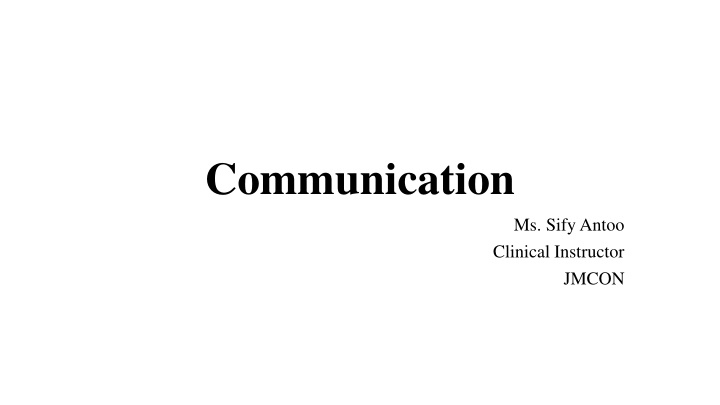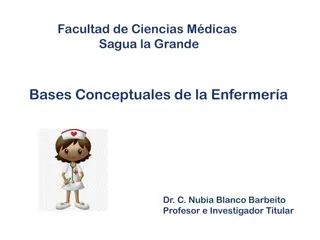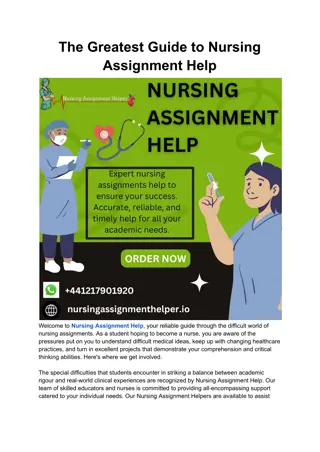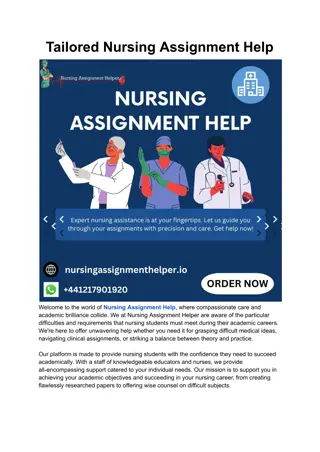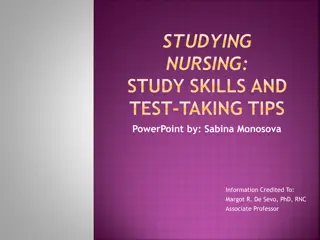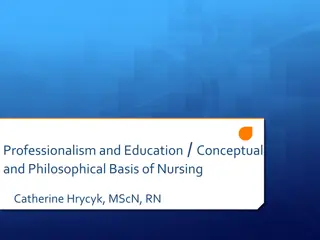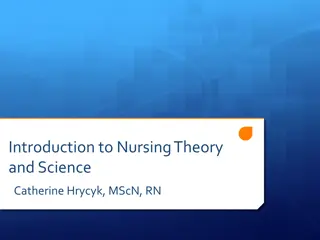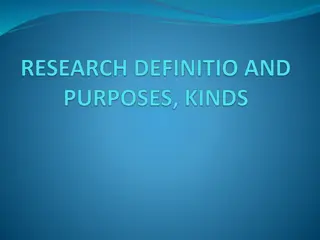Effective Communication Techniques in Nursing Education
Ms. Sify Antoo, a Clinical Instructor at JMCON, teaches students about communication techniques such as listening, broad openings, restating, clarification, and more. These skills are essential for nurses to establish rapport with patients, understand their needs, and provide effective care. By focusing on active listening, open-ended questions, and paraphrasing, nurses can enhance patient-centered communication and improve patient outcomes.
Download Presentation

Please find below an Image/Link to download the presentation.
The content on the website is provided AS IS for your information and personal use only. It may not be sold, licensed, or shared on other websites without obtaining consent from the author.If you encounter any issues during the download, it is possible that the publisher has removed the file from their server.
You are allowed to download the files provided on this website for personal or commercial use, subject to the condition that they are used lawfully. All files are the property of their respective owners.
The content on the website is provided AS IS for your information and personal use only. It may not be sold, licensed, or shared on other websites without obtaining consent from the author.
E N D
Presentation Transcript
Communication Ms. SifyAntoo Clinical Instructor JMCON
Central Objective By the end of the class students will gain the knowledge about communication & apply it favorably in their professional growth.
Specific Objective At the end of the class students will be able to: 1. Explain the techniques of communication.
Techniques of communication
Listening Broad openings Restating Clarification Reflection
Focusing Sharing perceptions Silence Humor Informing Suggesting
Listening An active process of receiving information. The complete attention of the nurse is required and there should be no preoccupation with oneself. Listening is a sign of respect for the person who is talking and a powerful reinforce of relationships. It allows the patients to talk more, without which the relationship cannot progress.
Broad openings These encourage the patient to select topicsfor discussion, and indicate that nurseis there listening to him and following him. For e.g. questions such as what shall we discuss today? can you tell me more about that ? And then what happened? From the part of the nurse encourages the patient to talk.
Restating/ Paraphrasing The nurse repeats to the patient the main thought in similar words that he has expressed. It indicates that the nurses is listening. It also brings attention to something important.
Clarification The person s verbalization, especially when he is disturbed or feeling deeply, is not always clear. The patients remarks may be confused, incomplete or disordered due to their illness. So, the nurses need to clarify the feelings and ideas expressed by the patients. The nurses need to provide correlation between the patient s feeling and action. For example- I am not sure what you mean? Could you tell me once again?
Reflection This means directing back to the patient his ideas, feeling, questions and content. Reflection of content is also called validation. Reflectionof feeling consists of responses of the patient s feeling about the content.
Focusing It means expanding the discussion on a topic of importance. Nurse uses focusing to guide the direction of conversation to important areas. It helps the patient to become more specific, move from vagueness to clarity and focus on reality.
Sharing perceptions: These are the techniques of asking the patient to verify the nurse understands of what he is thinking or feeling. For e.g. the nurse could ask the patient, as you are smiling, but I sense that you are really very angry with me.
Theme identification: This involves identifying the underlying issues or problem experienced by the patient that emerges repeatedly during the course of the nurse-patient interaction. Once we identify the basis themes, it becomes easy to decide which of the patient s feeling and thoughts to respond and pursue.
Silence This is lack of verbal communication for a therapeutic reason. The silence prompts the patient to talk. It allows the client to think & gain weight. For e.g. just sitting with a patient without talking, nonverbally communicates our interest in the patient better.
Humor This is the discharge of energy through the comic enjoyment of the imperfect. It is a part of nurse client relationship. it improves clients self esteem & made the nurses more approachable. It contributes the to feelings of togetherness, closeness & friendliness.
Informing This is the skill of giving information. The nurse shares simple facts with the patient. So they are able to make decisions, experience less anxiety & feel safe & secure.
Suggesting This is the presentation of alternative ideas related to problem solving. It is the most useful communication technique when the patient has analyzed his problem area, and is ready to explore alternative coping mechanisms. At that time suggesting technique increase the patient s choices.
Sharing observations Nurse make observations on commenting on how the other person looks, sounds or acts. Don t state the observation that will embarrass or anger the client.
Sharing empathy It is the ability to understand & accept another person s reality, to accurately perceives feelings and to communicate this understanding to the another.
Sharing hope Appropriate encouragement and positive feedback are important in fostering hope & self confidence & for helping people achieve their potential & reach their goals.
Sharing feelings Help the client to express emotions by making observations, acknowledging feelings, encouraging communication, giving permission to express negative feelings & modeling healthy emotional self expression.
Using Touch Comfort touch such as holding a hand will covey many messages such as affection, emotional support, encouragement & tenderness & personal attention.
Providing general leads Using statements or questions that encourage the client to verbalize, choose a topic of conversation & facilitate continued verbalization.
Being specific & tentative Making statements that are specific rather than general & tentative rather than absolute.
Asking relevant & open ended questions Asking relevant & open ended questions to seek information needed for decision making. You need to ask 1 question at a time & fully explore one topic before moving to another area.
Presenting reality Helping the patient to differentiate the real from unreal.
Self disclosure Nurse share experiences or feelings that are similar to those of the client. It shows client that the nurse can understand their experiences & their experiences are not unique. Def: these are subjectively true, personal experiences about the self that are intentionally revealed to another person.
Perception checking or seeking consensual validation A method to similar to clarifying that verifies the meaning of a specific word rather than the overall meaning of a message.
Offering self Suggesting one s presence, interest or wish to understand the client without making any demands or attaching conditions that the client must comply with to receive the nurse s attention.
Acknowledging Giving recognition in a non judgmental way , of a change in behavior, an effort that the client has made, or a contribution to a communication. It may be with or without understanding, verbal or non verbal.
Summarizing & planning Stating the main points of a discussion to clarify the relevant points discussed. It is useful at the end of an interview or to review a health teaching session.
Reference Audrey Berman, Shirlee Snyder, Kozier & Erb s, Fundamentals of Nursing, 9thedition, Pearson Publication. Patricia A Potter, Anne Griffin Perry, Fundamentals of Nursing, 6th edition, Mosby Publication. Taylor, Lillis, Lynn,Fundamentals of Nursing, 8thedition, Wolters Kluwer Publications. Dr. Valsamma Joseph, Susamma Varghese, Fundamentals of Nursing, 1thedition, 2018, Frontline Publications.
